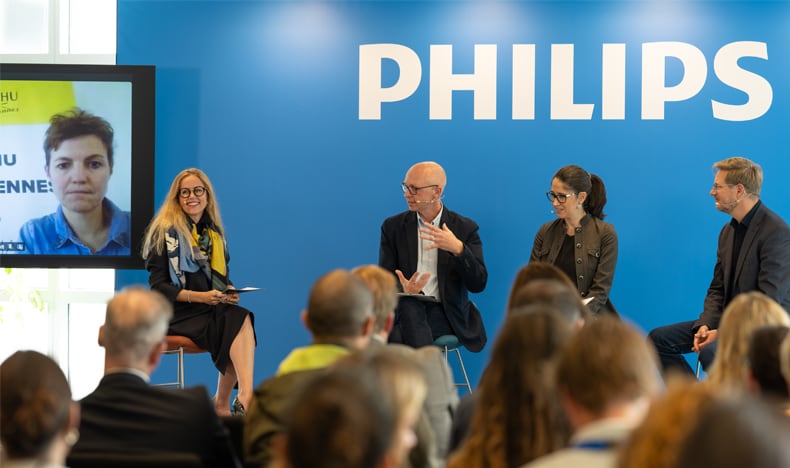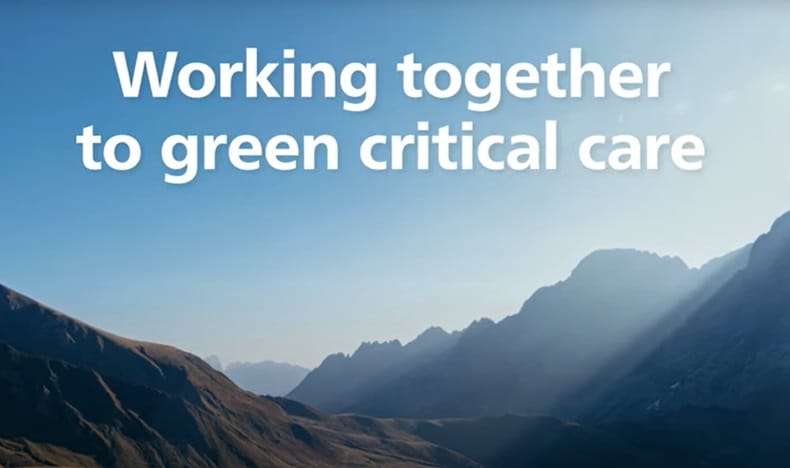The power of partnerships to drive sustainable and equitable healthcare
Oct 22, 2024 | 10 minute read
The healthcare industry has a responsibility to step up to address climate change, and the power to drive meaningful change. By collaborating with partners, together we can drive sustainable healthcare to benefit both the environment and the health of future generations. Leaders from several healthcare organizations share their firsthand experiences with sustainability.
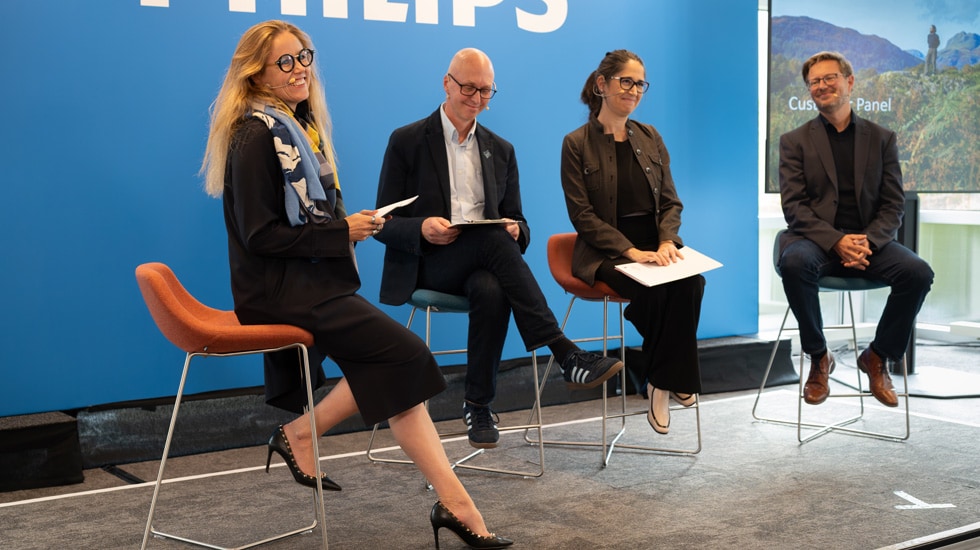
Healthcare professionals share their organizations’ experiences transitioning to sustainable healthcare, during a Philips panel event moderated by Clara Sattler de Sousa e Brito at Philips (left) and joined by Robert Metzke (right).
What if we looked at planet Earth as if it were a patient? What would we see? Droughts and floods, fires and melting ice, plastic pollution and ozone depletion. All symptoms that the planet is struggling. In the face of climate change, water and air pollution, and biodiversity loss, Earth’s global ecosystems and the health and well-being of millions of people are at risk. All of this puts a heavier burden on healthcare systems that are already struggling.
And, in addition to climate change’s impact on health and the sector’s impact on the environment, half of the world’s population still lacks access to healthcare.
Fortunately, health leaders increasingly recognize that a healthy planet is essential for the health of their patients and the wider population. And just like medical teams work together to treat patients in hospitals, people across the healthcare industry, too, are partnering to reduce CO2 emissions and waste and tackle the urgent challenges facing environmental and human health. By collaborating on creative solutions, we at Philips believe that we can drive sustainable and equitable healthcare.
As Philips Chief Medical Officer Carla Goulart Peron put it at a recent Sustainability Education Session: “How can we bring innovation to help us address some of the problems we have today without creating even more disruption?”
The need for sustainable and equitable healthcare
It’s time for the healthcare industry to step up. “The amount of waste we produce per bed, per hospital in some countries is unbelievable,” Goulart Peron said. "We need to take actions in making sure that we are doing the best we can to reduce that impact.” “Sometimes we forget to think about the fact that by taking care of people, we are also impacting the planet,” Goulart Peron said.
Our industry – from healthcare systems to health technology companies, policymakers to practitioners – has not only a responsibility to act, but also the power to drive meaningful change. By collaborating and sharing our knowledge, we can drive sustainable healthcare to benefit both the environment and the health of future generations.
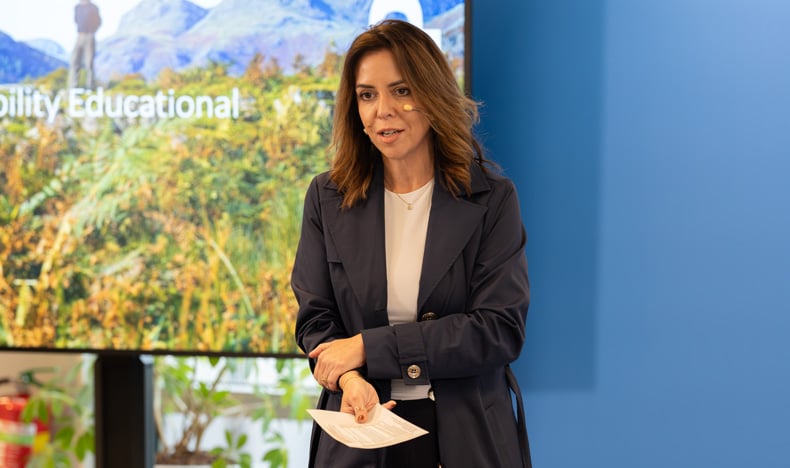
Carla Goulart Peron, Chief Medical Officer at Philips, says that there is a lot we can all do as individuals to help patients and the planet.
Working together to address health and environmental challenges
We’re not alone in this thinking. At Philips, we partner with frontrunner health systems from around the world that understand how critical it is to work together.
“Change is already underway, thanks to the passion and energy of some leaders in the healthcare space,” said Clara Sattler de Sousa e Brito, Head of Europe Region for Philips, who moderated a panel discussion about practical changes hospitals and healthcare settings can implement to accelerate their transition to sustainable healthcare. The panelists shared some of the day-to-day actions they are already implementing, including saving energy and reducing waste, ultimately impacting the supply pathways and holding partners to the highest ESG standards possible.
Because of the enormity of the climate challenge, no single party has all the answers, and no one can solve it on their own. As a health technology company, Philips believes that by partnering with care providers, practitioners, knowledge partners, and suppliers, we can scale sustainable practices and reduce our shared carbon footprint. Together we are creating a more resilient, sustainable and accessible healthcare industry, to deliver care to more patients and generations to come.
Let’s take a closer look at how three frontrunner health organizations are partnering to drive sustainable healthcare in action.
Philips and Champalimaud Foundation: partnering to halve the diagnostic imaging carbon footprint in five years
In Portugal, the healthcare system regularly makes news headlines, but not for the best reasons, said Joana Lamego, Head of Strategic Research Development at the Champalimaud Foundation, a leading Portuguese translational biomedical research and clinical care provider. The country’s system struggles to provide for the needs of patients today, she said, with pressures coming from the high workloads on professional staff and the need to invest in escalating treatment costs, R&D, modern equipment, and more. So where can sustainability fit into healthcare leaders’ priorities?
Recognizing the need for resilient and sustainable healthcare models, the Champalimaud Foundation aims to be the first carbon neutral clinic in Portugal.
We need to think globally and partner wisely. Sustainable healthcare is quite an endeavor, and we won’t be successful if we do this alone.
One year after signing a strategic partnership with Philips to reduce the carbon footprint of diagnostic and interventional imaging equipment, results are coming in. The emissions per exam in its radiology and nuclear medicine department were cut by approximately 24% in the first year of the partnership, primarily through EcoDesign equipment replacement and incorporating circular practices. Philips and Champalimaud will continue to reduce the environmental impact by enabling workflow improvements with software solutions and transitioning to renewable energy. Read the full case study here.
“How can we treat our patients today without compromising the health of generations to come? We need to think beyond environmental responsibility – we need to incorporate economic viability, social equity, preventative care. It’s a call to action,” Lamego said. “We need to think globally and partner wisely. Sustainable healthcare is quite an endeavor, and we won’t be successful if we do this alone.”
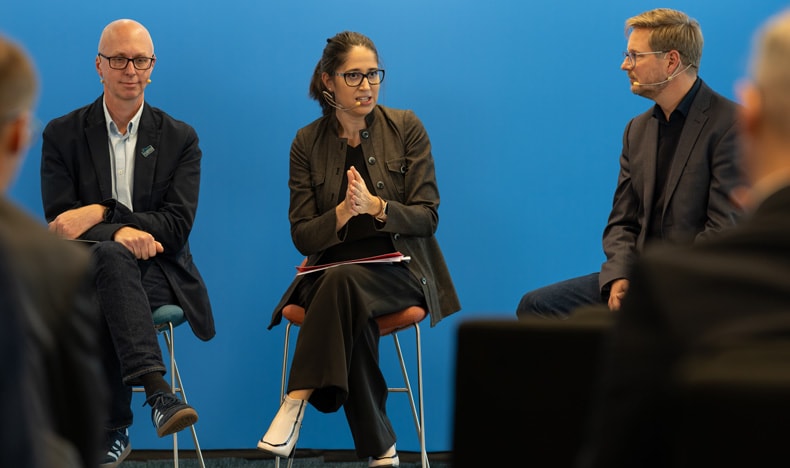
Joana Lamego, Head of Strategic Research Development at the Champalimaud Foundation, shares how the Foundation is driving sustainable healthcare in action.
Champalimaud has also found that by engaging their community – from top management to frontline providers to patients – sustainability can become a rallying point across their operations with a common sense of ownership. For instance, a group of nurses were deeply troubled by the waste they saw in their work. As part of the partnership with Philips but through a bottom-up initiative, the nurses are now running a pilot program to reduce waste by exploring more sustainable alternatives.
“Why are they doing this? It’s very simple,” said Lamego. “They want to be the motor of change. They are the ones saying they want to do this, and they are doing this on top of the daily clinical care of excellence they are providing to patients.”
Philips and County Durham and Darlington NHS Foundation Trust: partnering to make critical care more environmentally friendly
In the UK, acute and critical care makes up 56% of the carbon footprint of the NHS – and the demand is rising. County Durham and Darlington NHS Foundation Trust (CDDFT) understands that a sustainable future requires embracing partnerships and innovation, and identifying ways to drive the highest quality clinical care through environmental improvements.
Dr Richard Hixson, a consultant in anesthesia and critical care medicine at CDDFT, shared during the panel his initial surprise when he received a phone call from Philips with an offer to help identify opportunities to reduce greenhouse gas emissions and materials waste at Darlington Memorial Hospital.
“I thought as someone who had been working in sustainability for several years that I kind of had a handle on things, but suddenly there were these fresh eyes on our problems,” said Hixson, who was the planetary health lead at the Trust at the time. “We thought really holistically. Nothing was off the table. It wasn’t just about decarbonization, we really ended up with this focus on consumption, process, waste, pollution, and patient experience as well, which was really important.”
The Trust, with support from Philips, identified key areas where sustainability could be enhanced in ICU care, everything from discharging patients sooner to reducing waste in the supply chain, training staff and refurbishing buildings. This list formed a blueprint to drive further change across the Trust, in line with the UK National Health System’s goal to be the world’s first net zero national health service by 2040. Read the full case study here.
“We started delivering actions way before we even finished the report out,” Hixson said. “One of the biggest things we did was to include sustainability as part of our multidisciplinary critical care huddle every single day, and we had a checklist.”
Sustainability became part of the decision-making process across the hospital – with a common sense of ownership that allowed it to become part of the culture.
“Suddenly everybody wanted to talk about what we were doing with Philips,” Hixson said. “Everyone got it. Sustainability was part of what they expected us to do. We explored areas that we never thought we would explore. The outcomes have been fantastic, and we’ve done the most important thing with those outcomes – we’ve communicated them. We have to drive change – not just within healthcare, but in every industry across the planet.”
And this partnership led to further action that could have greater impact worldwide. Since the NHS is heavily dependent on the shipping industry for health supplies, any disruptions to shipping could severely impact healthcare across the British Isles, Hixson said. Thanks to the relationship with the Trust, Philips was inspired to take further action on sustainable logistics. Philips was one of 19 global brands that signed up to the coZEV initiative’s 2040 zero-carbon ocean shipping ambition.
“If hospitals really formulate what they want from us in the industry, it has such a ripple effect – also going through industries, through our supply chains, and that drives change,” said Robert Metzke, Global Head of Sustainability at Philips.
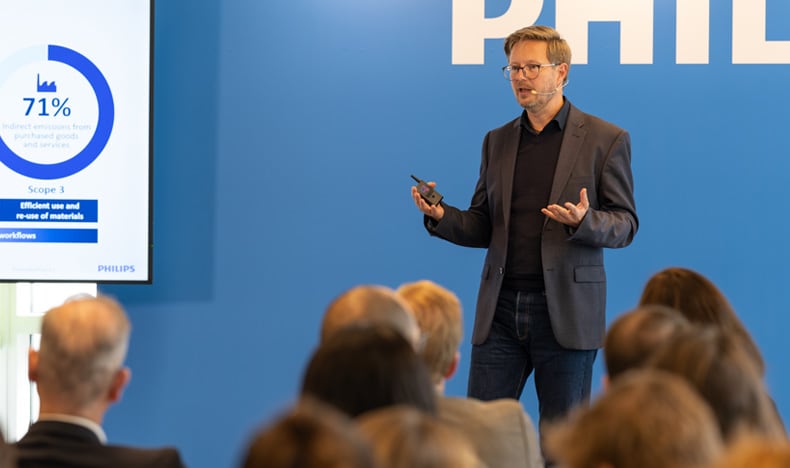
Robert Metzke, Global Head of Sustainability at Philips, says that everyone across the healthcare industry has a role to play in driving sustainable healthcare.
Philips and Rennes University Hospital: partnering for a sustainable cath lab
Healthcare accounts for nearly 8% of global CO2 emissions in France, nearly double the global average [1]. Rennes University Hospital also identified that medical equipment purchases accounted for nearly half (44%) of its own total emissions, highlighting the need to develop a sustainable procurement strategy and to collaborate with industry stakeholders to address sustainability challenges through a systemic approach.
“We need to continue providing care, we need to respond to the increasing health needs, while also reducing our environmental footprint,” said Anne Kittler, Deputy Director General of Rennes University Hospital.
As part of a five-year technology, research, and innovation partnership with Philips, Rennes aimed to decarbonize and reduce the overall environmental impact of its catheterization laboratory (cath lab), in which a Philips Image Guided Therapy System – Azurion – is used to treat strokes and aneurysms. Rennes and Philips conducted a Life Cycle Assessment to identify the carbon footprint and other impacts associated with the Azurion and the consumables used during interventional procedures. This revealed opportunities to reduce the lab’s annual emissions through energy savings, circular upgrades and refurbishment. Read the full case study here.
We need a revolution, and every contribution counts for global change. We need absolutely everyone.
The hospital is addressing sustainability through multiple approaches, Anne Kittler explained. For example, it is exploring when and how to use fewer consumables during patient care and providing electric bicycles to staff to reduce their commuting emissions. It is also invested in preventive care, because keeping people healthy reduces the need for later treatment, thereby lowering the environmental impact of healthcare.
She said everyone – from cleaners to pharmacists, secretaries to doctors, nurses to patients – can contribute.
“We need a revolution, and every contribution counts for global change,” Anne Kittler said. “We need absolutely everyone.”
The power of concerted action
So what do partnerships like these – and with other customers such as Vanderbilt University Medical Center and Jackson Health System – have in common? They each reflect a commitment by partners to help mitigate climate change and biodiversity loss by driving systemic change toward more accessible and sustainable patient care. That requires collaboration – across the healthcare value chain and in every aspect of the enterprise (procurement, operations, innovation, service delivery and beyond). Through partnerships, Philips can help healthcare providers address their clinical and operational challenges, and at the same time adopt sustainable ways of working. We do this through a set of practical, scalable measures and circular innovations, including EcoDesign of equipment, lifetime extension programs (e.g., upgrades and/or refurbishment), digitalization of workflows for care pathway optimization, circular financing solutions with equipment take-back, and responsible end-of-use management to avoid waste going to landfill.
Examples like these are greatly encouraging, as they illustrate how more and more healthcare providers are prioritizing and embedding sustainability in their operations. Combining sustainable practices with safe, efficient and effective methods of care makes it possible to deliver better patient outcomes and experiences.
By working together, we can take better care of people with less impact on the planet.
Sources [1] The Shift Project. Décarboner la Santé pour Soigner Durablement (2023).


